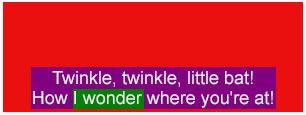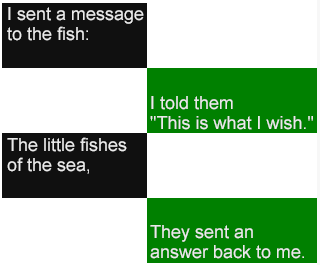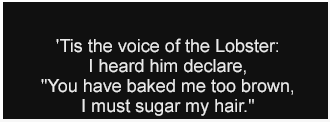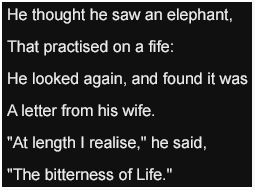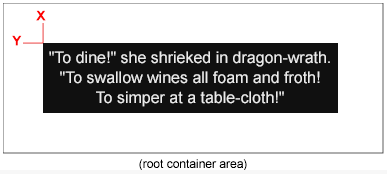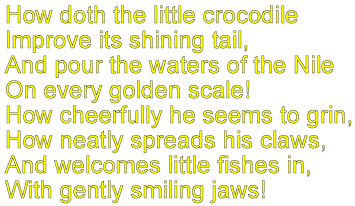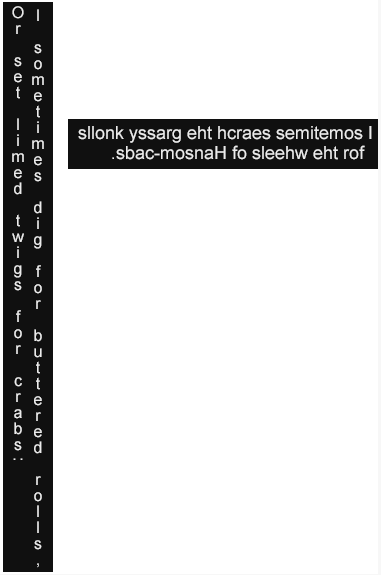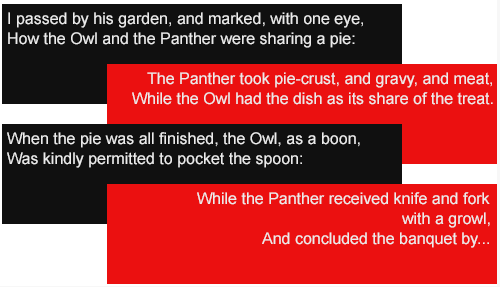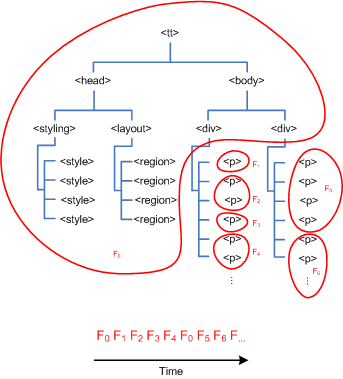This appendix specifies (1) a set of feature designations, each
of which labels one or more syntactic and/or semantic features
defined by this specification, and (2) for each designated feature,
whether the feature is mandatory or optional for a transformation
or presentation processor.
E.1 Feature Designations
A feature designation is expressed as a string that adheres to
the following form:
feature-designation
: feature-namespace designation
feature-namespace
: TT Feature Namespace // http://www.w3.org/2006/10/ttaf1/feature
designation
: "#" token-char+
token-char
: { XML NameChar } // XML 1.1 Production [4a]
All values of feature-designation not defined by
this specification are reserved for future standardization.
The following sub-sections define all feature designations,
expressed as relative URIs (fragment identifiers) with respect to
the TT Feature Namespace base URI.
E.1.1
#animation
A TT AF transformation processor supports the
#animation feature if it recognizes and is capable of
transforming the following vocabulary defined by 11 Animation :
A TT AF presentation processor supports the
#animation feature if it implements presentation
semantic support for the same vocabulary enumerated above.
E.1.2 #backgroundColor
A TT AF transformation processor supports the
#backgroundColor feature if it recognizes and is
capable of transforming the tts:backgroundColor
attribute.
A TT AF presentation processor supports the
#backgroundColor feature if it (1) implements
presentation semantic support for the tts:backgroundColor
attribute and (2) is capable of displaying or generating an output
display signal that distinguishes between at least sixteen (16)
values of color, including all primary and secondary colors of the
SRGB color space.
E.1.3
#backgroundColor-block
A TT AF transformation processor supports the
#backgroundColor-block feature if it recognizes and is
capable of transforming all defined values of the tts:backgroundColor
attribute when applied to a content element that would generate a
block area during presentation processing.
A TT AF presentation processor supports the
#backgroundColor-block feature if it (1) implements
presentation semantic support for the tts:backgroundColor
attribute when applied to a content element that generates a block
area and (2) is capable of displaying or generating an output
display signal that distinguishes between at least sixteen (16)
values of color, including all primary and secondary colors of the
SRGB color space.
E.1.4
#backgroundColor-inline
A TT AF transformation processor supports the
#backgroundColor-inline feature if it recognizes and
is capable of transforming all defined values of the tts:backgroundColor
attribute when applied to a content element that would generate an
inline area during presentation processing.
A TT AF presentation processor supports the
#backgroundColor-inline feature if it (1) implements
presentation semantic support for the tts:backgroundColor
attribute when applied to a content element that generates an
inline area and (2) is capable of displaying or generating an
output display signal that distinguishes between at least sixteen
(16) values of color, including all primary and secondary colors of
the SRGB color space.
E.1.5
#backgroundColor-region
A TT AF transformation processor supports the
#backgroundColor-region feature if it recognizes and
is capable of transforming all defined values of the tts:backgroundColor
attribute when applied to a region element.
A TT AF presentation processor supports the
#backgroundColor-region feature if it (1) implements
presentation semantic support for the tts:backgroundColor
attribute when applied to a region element and (2)
is capable of displaying or generating an output display signal
that distinguishes between at least sixteen (16) values of color,
including all primary and secondary colors of the SRGB color space
.
E.1.6 #bidi
A TT AF processor supports the #bidi feature if it
supports the following features:
E.1.7 #cellResolution
A TT AF transformation processor supports the
#cellResolution feature if it recognizes and is
capable of transforming the ttp:cellResolution
attribute.
A TT AF presentation processor supports the
#cellResolution feature if it implements presentation
semantic support for the ttp:cellResolution
attribute.
E.1.8
#clockMode
A TT AF transformation processor supports the
#clockMode feature if it recognizes and is capable of
transforming the ttp:clockMode
attribute.
A TT AF presentation processor supports the
#clockMode feature if it implements presentation
semantic support for the ttp:clockMode
attribute.
E.1.9
#color
A TT AF transformation processor supports the
#color feature if it recognizes and is capable of
transforming the tts:color attribute.
A TT AF presentation processor supports the #color
feature if it (1) implements presentation semantic support for the
tts:color
attribute and (2) is capable of displaying or generating an output
display signal that distinguishes between at least sixteen (16)
values of color, including all primary and secondary colors of the
SRGB color space.
E.1.10
#content
A TT AF transformation processor supports the
#content feature if it recognizes and is capable of
transforming the following vocabulary defined by 7 Content :
A TT AF presentation processor supports the
#content feature if it implements presentation
semantic support for the same vocabulary enumerated above.
E.1.11 #core
A TT AF transformation processor supports the #core
feature if it recognizes and is capable of transforming the
following core attributes vocabulary defined by 7 Content :
A TT AF presentation processor supports the #core
feature if it implements presentation semantic support for the same
vocabulary enumerated above.
E.1.12
#direction
A TT AF transformation processor supports the
#direction feature if it recognizes and is capable of
transforming all defined values of the tts:direction
attribute.
A TT AF presentation processor supports the
#direction feature if it implements presentation
semantic support for all defined values of the tts:direction
attribute.
E.1.13
#display
A TT AF transformation processor supports the
#display feature if it recognizes and is capable of
transforming all defined values of the tts:display
attribute.
A TT AF presentation processor supports the
#display feature if it implements presentation
semantic support for all defined values of the tts:display
attribute.
E.1.14 #display-block
A TT AF transformation processor supports the
#display-block feature if it recognizes and is capable
of transforming all defined values of the tts:display attribute
when applied to a content element that would generate a block area
during presentation processing.
A TT AF presentation processor supports the
#display-block feature if it implements presentation
semantic support for all defined values of the tts:display attribute
when applied to a content element that generates a block area.
E.1.15 #display-inline
A TT AF transformation processor supports the
#display-inline feature if it recognizes and is
capable of transforming all defined values of the tts:display attribute
when applied to a content element that would generate an inline
area during presentation processing.
A TT AF presentation processor supports the
#display-inline feature if it implements presentation
semantic support for all defined values of the tts:display attribute
when applied to a content element that generates an inline
area.
E.1.16 #display-region
A TT AF transformation processor supports the
#display-region feature if it recognizes and is
capable of transforming all defined values of the tts:display attribute
when applied to a region element.
A TT AF presentation processor supports the
#display-region feature if it implements presentation
semantic support for all defined values of the tts:display attribute
when applied to a region element.
E.1.17 #displayAlign
A TT AF transformation processor supports the
#displayAlign feature if it recognizes and is capable
of transforming all defined values of the tts:displayAlign
attribute.
A TT AF presentation processor supports the
#displayAlign feature if it implements presentation
semantic support for all defined values of the tts:displayAlign
attribute.
E.1.18 #dynamicFlow
A TT AF transformation processor supports the
#dynamicFlow feature if it recognizes and is capable
of transforming all defined values of the tts:dynamicFlow
attribute.
A TT AF presentation processor supports the
#dynamicFlow feature if it implements presentation
semantic support for all defined values of the tts:dynamicFlow
attribute.
E.1.19 #dynamicFlow-block A TT AF
transformation processor supports the #dynamicFlow-block feature if
it recognizes and is capable of transforming the flow unit block as
defined by 8.3.6 <flowFunction> when used with the
tts:dynamicFlow attribute. A TT AF presentation processor supports
the #dynamicFlow-block feature if it implements presentation
semantic support for the flow unit block as defined by 8.3.6
<flowFunction> when used with the tts:dynamicFlow
attribute. E.1.20 E.1.19
#dynamicFlow-character
A TT AF transformation processor supports the
#dynamicFlow-character feature if it recognizes and is
capable of transforming the flow unit character as
defined by 8.3.6
<flowFunction> when used with the tts:dynamicFlow
attribute.
A TT AF presentation processor supports the
#dynamicFlow-character feature if it implements
presentation semantic support for the flow unit
character as defined by 8.3.6 <flowFunction>
when used with the tts:dynamicFlow
attribute.
E.1.21 #dynamicFlow-glyph
E.1.20 #dynamicFlow-clear
A TT AF transformation processor supports the #dynamicFlow-glyph #dynamicFlow-clearunit interval function
glyph clear(..)8.3.6
<flowFunction> 8.3.7
<flowIntervalFunction> when used with the
tts:dynamicFlow
attribute.
A TT AF presentation processor supports the #dynamicFlow-glyph #dynamicFlow-clearunit interval function
glyph clear(..)tts:dynamicFlow
attribute.
E.1.22 #dynamicFlow-in
E.1.21 #dynamicFlow-fill
A TT AF transformation processor supports the #dynamicFlow-in #dynamicFlow-fillin(..) fill(..)8.3.6
<flowFunction> 8.3.7
<flowIntervalFunction> when used with the
tts:dynamicFlow
attribute.
A TT AF presentation processor supports the #dynamicFlow-in #dynamicFlow-fillin(..) fill(..)tts:dynamicFlow
attribute.
E.1.23 #dynamicFlow-inline
E.1.22 #dynamicFlow-glyph
A TT AF transformation processor supports the #dynamicFlow-inline #dynamicFlow-glyphinline glyphtts:dynamicFlow
attribute.
A TT AF presentation processor supports the #dynamicFlow-inline #dynamicFlow-glyphinline glyphtts:dynamicFlow
attribute.
E.1.24 #dynamicFlow-inter
E.1.23 #dynamicFlow-in
A TT AF transformation processor supports the #dynamicFlow-inter #dynamicFlow-ininterval function inter(..) as defined by 8.3.7
<flowIntervalFunction> when used with the tts:dynamicFlow
attribute. A TT AF presentation processor supports the
#dynamicFlow-inter feature if it implements presentation semantic
support for the flow interval function inter(..) in(..)tts:dynamicFlow
attribute.
E.1.25 #dynamicFlow-intra A TT AF
transformation processor supports the #dynamicFlow-intra feature if
it recognizes and is capable of transforming the flow interval
function intra(..) as defined by 8.3.7 <flowIntervalFunction>
when used with the tts:dynamicFlow attribute.
A TT AF presentation processor supports the #dynamicFlow-intra #dynamicFlow-ininterval function intra(..) in(..)tts:dynamicFlow
attribute.
E.1.26
E.1.24 #dynamicFlow-jump
A TT AF transformation processor supports the
#dynamicFlow-jump feature if it recognizes and is
capable of transforming the flow style jump as defined
by 8.3.6
<flowFunction> when used with the tts:dynamicFlow
attribute.
A TT AF presentation processor supports the
#dynamicFlow-jump feature if it implements
presentation semantic support for the flow style jump
as defined by 8.3.6
<flowFunction> when used with the tts:dynamicFlow
attribute.
E.1.27
E.1.25 #dynamicFlow-line
A TT AF transformation processor supports the
#dynamicFlow-line feature if it recognizes and is
capable of transforming the flow unit line as defined
by 8.3.6
<flowFunction> when used with the tts:dynamicFlow
attribute.
A TT AF presentation processor supports the
#dynamicFlow-line feature if it implements
presentation semantic support for the flow unit line
as defined by 8.3.6
<flowFunction> when used with the tts:dynamicFlow
attribute.
E.1.28
E.1.26 #dynamicFlow-out
A TT AF transformation processor supports the
#dynamicFlow-out feature if it recognizes and is
capable of transforming the flow function out(..) as
defined by 8.3.6
<flowFunction> when used with the tts:dynamicFlow
attribute.
A TT AF presentation processor supports the
#dynamicFlow-out feature if it implements presentation
semantic support for the flow function out(..) as
defined by 8.3.6
<flowFunction> when used with the tts:dynamicFlow
attribute.
E.1.29 E.1.27
#dynamicFlow-rollUp
A TT AF transformation processor supports the
#dynamicFlow-rollUp feature if it recognizes and is
capable of transforming the rollUp value of the
tts:dynamicFlow
attribute.
A TT AF presentation processor supports the
#dynamicFlow-rollUp feature if it implements
presentation semantic support for the rollUp of the
tts:dynamicFlow
attribute.
E.1.30 E.1.28
#dynamicFlow-smooth
A TT AF transformation processor supports the
#dynamicFlow-smooth feature if it recognizes and is
capable of transforming the flow style smooth as
defined by 8.3.6
<flowFunction> when used with the tts:dynamicFlow
attribute.
A TT AF presentation processor supports the
#dynamicFlow-smooth feature if it implements
presentation semantic support for the flow style
smooth as defined by 8.3.6 <flowFunction>
when used with the tts:dynamicFlow
attribute.
E.1.31 E.1.29
#dynamicFlow-teletext
A TT AF transformation processor supports the
#dynamicFlow-teletext feature if it recognizes and is
capable of transforming any well-defined value of the tts:dynamicFlow
attribute that is equivalent to in(glyph,jump)
out(line,jump) .
A TT AF presentation processor supports the
#dynamicFlow-teletext feature if it implements
presentation semantic support for any well-defined value of the
tts:dynamicFlow
attribute that is equivalent to in(glyph,jump)
out(line,jump) .
E.1.32
E.1.30 #dynamicFlow-word
A TT AF transformation processor supports the
#dynamicFlow-word feature if it recognizes and is
capable of transforming the flow unit word as defined
by 8.3.6
<flowFunction> when used with the tts:dynamicFlow
attribute.
A TT AF presentation processor supports the
#dynamicFlow-word feature if it implements
presentation semantic support for the flow unit word
as defined by 8.3.6
<flowFunction> when used with the tts:dynamicFlow
attribute.
E.1.33 E.1.31
#extent
A TT AF transformation processor supports the
#extent feature if it recognizes and is capable of
transforming the tts:extent
attribute.
A TT AF presentation processor supports the #extent
feature if it implements presentation semantic support for the
tts:extent
attribute.
E.1.34 E.1.32 #fontFamily
A TT AF transformation processor supports the
#fontFamily feature if it recognizes and is capable of
transforming the tts:fontFamily
attribute.
A TT AF presentation processor supports the
#fontFamily feature if it implements presentation
semantic support for the tts:fontFamily
attribute.
E.1.35 E.1.33
#fontFamily-generic
A TT AF transformation processor supports the
#fontFamily-generic feature if it recognizes and is
capable of transforming <genericFamilyName>
values when used with the tts:fontFamily
attribute.
A TT AF presentation processor supports the
#fontFamily-generic feature if it implements
presentation semantic support for <genericFamilyName>
values when used with the tts:fontFamily
attribute.
E.1.36 E.1.34
#fontFamily-non-generic
A TT AF transformation processor supports the
#fontFamily-non-generic feature if it recognizes and
is capable of transforming <familyName> values when used
with the tts:fontFamily
attribute.
A TT AF presentation processor supports the
#fontFamily-non-generic feature if it implements
presentation semantic support for <familyName> values when used
with the tts:fontFamily
attribute.
E.1.37 E.1.35 #fontSize
A TT AF transformation processor supports the
#fontSize feature if it recognizes and is capable of
transforming the tts:fontSize
attribute.
A TT AF presentation processor supports the
#fontSize feature if it implements presentation
semantic support for the tts:fontSize
attribute.
E.1.38 E.1.36
#fontSize-anisomorphic
A TT AF transformation processor supports the
#fontSize-anisomorphic feature if it recognizes and is
capable of transforming values of the tts:fontSize attribute
that consist of two <length> specifications.
A TT AF presentation processor supports the
#fontSize-anisomorphic feature if it implements
presentation semantic support for defined values of the tts:fontSize attribute
that consist of two <length> specifications.
E.1.39 E.1.37
#fontSize-isomorphic
A TT AF transformation processor supports the
#fontSize-isomorphic feature if it recognizes and is
capable of transforming values of the tts:fontSize attribute
that consist of a single <length> specification.
A TT AF presentation processor supports the
#fontSize-isomorphic feature if it implements
presentation semantic support for defined values of the tts:fontSize attribute
that consist of a single <length> specification.
E.1.40 E.1.38 #fontStyle
A TT AF transformation processor supports the
#fontStyle feature if it recognizes and is capable of
transforming all defined values of the tts:fontStyle
attribute.
A TT AF presentation processor supports the
#fontStyle feature if it implements presentation
semantic support for all defined values of the tts:fontStyle
attribute.
E.1.41
E.1.39 #fontStyle-italic
A TT AF transformation processor supports the
#fontStyle-italic feature if it recognizes and is
capable of transforming the italic value of the
tts:fontStyle
attribute.
A TT AF presentation processor supports the
#fontStyle-italic feature if it implements
presentation semantic support for the italic of the
tts:fontStyle
attribute.
E.1.42 E.1.40 #fontWeight
A TT AF transformation processor supports the
#fontWeight feature if it recognizes and is capable of
transforming all defined values of the tts:fontWeight
attribute.
A TT AF presentation processor supports the
#fontWeight feature if it implements presentation
semantic support for all defined values of the tts:fontWeight
attribute.
E.1.43
E.1.41 #fontWeight-bold
A TT AF transformation processor supports the
#fontWeight-bold feature if it recognizes and is
capable of transforming bold value of the tts:fontWeight
attribute.
A TT AF presentation processor supports the
#fontWeight-bold feature if it implements presentation
semantic support for the bold of the tts:fontWeight
attribute.
E.1.44 E.1.42 #frameRate
A TT AF transformation processor supports the
#frameRate feature if it recognizes and is capable of
transforming the ttp:frameRate
attribute.
A TT AF presentation processor supports the
#frameRate feature if it implements presentation
semantic support for the ttp:frameRate
attribute.
E.1.45 E.1.43
#frameRateMultiplier
A TT AF transformation processor supports the
#frameRateMultiplier feature if it recognizes and is
capable of transforming the ttp:frameRateMultiplier
attribute.
A TT AF presentation processor supports the
#frameRateMultiplier feature if it implements
presentation semantic support for the ttp:frameRateMultiplier
attribute.
E.1.46 E.1.44
#layout
A TT AF transformation processor supports the
#layout feature if it (1) recognizes and is capable of
transforming the following vocabulary defined by 9 Layout :
and (2) supports the following attributes when applied to the
region
element:
A TT AF presentation processor supports the #layout
feature if it implements presentation semantic support for the same
vocabulary and features enumerated above.
E.1.47 E.1.45
#length
A TT AF transformation processor supports the
#length feature if it recognizes and is capable of
transforming all defined values of the <length> style value
expression.
A TT AF presentation processor supports the #length
feature if it implements presentation semantic support for all
defined values of the <length> style value
expression.
E.1.48 E.1.46 #length-cell
A TT AF transformation processor supports the
#length-cell feature if it recognizes and is capable
of transforming scalar values of the <length> style value expression
that use c (cell) units.
A TT AF presentation processor supports the
#length-cell feature if it implements presentation
semantic support for scalar values of the <length> style value expression
that use c (cell) units.
E.1.49 E.1.47 #length-em
A TT AF transformation processor supports the
#length-em feature if it recognizes and is capable of
transforming scalar values of the <length> style value expression
that use em (EM) units.
A TT AF presentation processor supports the
#length-em feature if it implements presentation
semantic support for scalar values of the <length> style value expression
that use em (EM) units.
E.1.50
E.1.48 #length-integer
A TT AF transformation processor supports the
#length-integer feature if it recognizes and is
capable of transforming integer values of the <length> style value
expression.
A TT AF presentation processor supports the
#length-integer feature if it implements presentation
semantic support for integer values of the <length> style value
expression.
E.1.51
E.1.49 #length-negative
A TT AF transformation processor supports the
#length-negative feature if it recognizes and is
capable of transforming negative values of the <length> style value
expression.
A TT AF presentation processor supports the
#length-negative feature if it implements presentation
semantic support for negative values of the <length> style value
expression.
E.1.52
E.1.50 #length-percentage
A TT AF transformation processor supports the
#length-percentage feature if it recognizes and is
capable of transforming percentage values of the <length> style value
expression.
A TT AF presentation processor supports the
#length-percentage feature if it implements
presentation semantic support for percentage values of the <length> style value
expression.
E.1.53 E.1.51 #length-pixel
A TT AF transformation processor supports the
#length-pixel feature if it recognizes and is capable
of transforming scalar values of the <length> style value expression
that use px (pixel) units.
A TT AF presentation processor supports the
#length-pixel feature if it implements presentation
semantic support for scalar values of the <length> style value expression
that use px (pixel) units.
E.1.54
E.1.52 #length-positive
A TT AF transformation processor supports the
#length-positive feature if it recognizes and is
capable of transforming positive values of the <length> style value
expression.
A TT AF presentation processor supports the
#length-positive feature if it implements presentation
semantic support for positive values of the <length> style value
expression.
E.1.55 E.1.53 #length-real
A TT AF transformation processor supports the
#length-real feature if it recognizes and is capable
of transforming real values of the <length> style value
expression.
A TT AF presentation processor supports the
#length-real feature if it implements presentation
semantic support for real values of the <length> style value
expression.
E.1.54
#lineBreak-uax14
A TT AF transformation processor supports
the #lineBreak-uax14
feature if it recognizes and is capable of
transforming requirements expressed by [UAX14] into its target document space.
A TT AF presentation processor supports
the #lineBreak-uax14
feature if it implements presentation
semantic support for [UAX14] as applies to
line breaking.
E.1.56 E.1.55 #lineHeight
A TT AF transformation processor supports the
#lineHeight feature if it recognizes and is capable of
transforming the tts:lineHeight
attribute.
A TT AF presentation processor supports the
#lineHeight feature if it implements presentation
semantic support for the tts:lineHeight
attribute.
E.1.57 E.1.56 #markerMode
A TT AF transformation processor supports the
#markerMode feature if it recognizes and is capable of
transforming the ttp:markerMode
attribute.
A TT AF presentation processor supports the
#markerMode feature if it implements presentation
semantic support for the ttp:markerMode
attribute.
E.1.58 E.1.57 #metadata
A TT AF transformation processor supports the
#metadata feature if it recognizes and is capable of
transforming the following vocabulary defined by 12 Metadata :
A TT AF presentation processor supports the
#metadata feature if it recognizes and is capable of
presenting the information expressed by the same vocabulary
enumerated above.
Note:
This specification does not define a standardized form for the
presentation of metadata information. The presentation or ability
to present metadata information is considered to be implementation
dependent.
E.1.59 E.1.58 #nested-div
A TT AF transformation processor supports the
#nested-div feature if it recognizes and is capable of
transforming nested div elements.
A TT AF presentation processor supports the
#nested-div feature if it implements presentation
semantic support for nested div elements.
E.1.60 E.1.59 #nested-span
A TT AF transformation processor supports the
#nested-span feature if it recognizes and is capable
of transforming nested span elements.
A TT AF presentation processor supports the
#nested-span feature if it implements presentation
semantic support for nested span elements.
E.1.61 E.1.60
#opacity
A TT AF transformation processor supports the
#opacity feature if it recognizes and is capable of
transforming the tts:opacity
attribute.
A TT AF presentation processor supports the
#opacity feature if it (1) implements presentation
semantic support for the tts:opacity attribute
and (2) is capable of displaying or generating an output display
signal that distinguishes between at least eight (8) values of
opacity.
E.1.62 E.1.61
#origin
A TT AF transformation processor supports the
#origin feature if it recognizes and is capable of
transforming the tts:origin
attribute.
A TT AF presentation processor supports the #origin
feature if it implements presentation semantic support for the
tts:origin
attribute.
E.1.63 E.1.62 #overflow
A TT AF transformation processor supports the
#overflow feature if it recognizes and is capable of
transforming all defined values of the tts:overflow
attribute.
A TT AF presentation processor supports the
#overflow feature if it implements presentation
semantic support for all defined values of the tts:overflow
attribute.
E.1.64
E.1.63 #overflow-dynamic
A TT AF transformation processor supports the
#overflow-dynamic feature if it recognizes and is
capable of transforming the dynamic value of the
tts:overflow
attribute.
A TT AF presentation processor supports the
#overflow-dynamic feature if it implements
presentation semantic support for the dynamic value of
the tts:overflow
attribute.
E.1.65 E.1.64
#padding
A TT AF transformation processor supports the
#padding feature if it recognizes and is capable of
transforming the tts:padding
attribute.
A TT AF presentation processor supports the
#padding feature if it implements presentation
semantic support for the tts:padding
attribute.
E.1.66 E.1.65 #padding-1
A TT AF transformation processor supports the
#padding-1 feature if it recognizes and is capable of
transforming values of the tts:padding attribute
that consist of one <length> specification.
A TT AF presentation processor supports the
#padding-1 feature if it implements presentation
semantic support for values of the tts:padding attribute
that consist of one <length> specification.
E.1.67 E.1.66 #padding-2
A TT AF transformation processor supports the
#padding-2 feature if it recognizes and is capable of
transforming values of the tts:padding attribute
that consist of two <length> specification.
A TT AF presentation processor supports the
#padding-2 feature if it implements presentation
semantic support for values of the tts:padding attribute
that consist of two <length> specification.
E.1.68 E.1.67 #padding-3
A TT AF transformation processor supports the
#padding-3 feature if it recognizes and is capable of
transforming values of the tts:padding attribute
that consist of three <length> specification.
A TT AF presentation processor supports the
#padding-3 feature if it implements presentation
semantic support for values of the tts:padding attribute
that consist of three <length> specification.
E.1.69 E.1.68 #padding-4
A TT AF transformation processor supports the
#padding-4 feature if it recognizes and is capable of
transforming values of the tts:padding attribute
that consist of four <length> specification.
A TT AF presentation processor supports the
#padding-4 feature if it implements presentation
semantic support for values of the tts:padding attribute
that consist of four <length> specification.
E.1.70
E.1.69 #pixelAspectRatio
A TT AF transformation processor supports the
#pixelAspectRatio feature if it recognizes and is
capable of transforming the ttp:pixelAspectRatio
attribute.
A TT AF presentation processor supports the
#pixelAspectRatio feature if it implements
presentation semantic support for the ttp:pixelAspectRatio
attribute.
E.1.71 E.1.70 #presentation
A TT AF processor supports the #presentation
feature if it is a compliant TT AF
Presentation Processor as (1) satisfies
the generic processor criteria defined by 3.2
3.2.1 Generic Processor
Conformance , (2) implements support
for the region and line layout semantics defined by 9.3 Region
Layout and Presentation and 9.4 Line
Layout ,respectively, and (3)
implements presentation semantics for the following
features:
In addition, a TT AF processor that
supports the #presentation feature
should satisfy the user agent accessibility guidelines specified
by [UAAG]
.
E.1.72 E.1.71
#profile
A TT AF transformation processor supports the
#profile feature if it recognizes and is capable of
transforming the ttp:profile
attribute on the tt element and
transforming the following vocabulary defined by 6.1 Parameter Element
Vocabulary :
A TT AF presentation processor supports the
#profile feature if it implements presentation
semantic support for the same vocabulary specified above.
E.1.73 E.1.72
#rollUp
A TT AF processor supports the #rollUp feature if
it supports the following features:
E.1.74
E.1.73 #showBackground
A TT AF transformation processor supports the
#showBackground feature if it recognizes and is
capable of transforming all defined values of the tts:showBackground
attribute.
A TT AF presentation processor supports the
#showBackground feature if it implements presentation
semantic support for all defined values of the tts:showBackground
attribute.
E.1.75 E.1.74 #smpteMode
A TT AF transformation processor supports the
#smpteMode feature if it recognizes and is capable of
transforming the ttp:smpteMode
attribute.
A TT AF presentation processor supports the
#smpteMode feature if it implements presentation
semantic support for the ttp:smpteMode
attribute.
E.1.76 E.1.75 #structure
A TT AF transformation processor supports the
#structure feature if it recognizes and is capable of
transforming the following vocabulary defined by 7 Content :
A TT AF presentation processor supports the
#structure feature if it implements presentation
semantic support for the same vocabulary enumerated above.
E.1.77 E.1.76
#styling
A TT AF transformation processor supports the
#styling feature if it recognizes and is capable of
transforming the following vocabulary defined by 8 Styling :
A TT AF presentation processor supports the
#styling feature if it implements presentation
semantic support for the same vocabulary enumerated above.
E.1.78
E.1.77 #styling-chained
A TT AF transformation processor supports the
#styling-chained feature if it recognizes and is
capable of transforming chained style association as defined by
8.4.1.3
Chained Referential Styling .
A TT AF presentation processor supports the
#styling-chained feature if it implements presentation
semantic support for chained style association as defined by
8.4.1.3
Chained Referential Styling .
E.1.79 E.1.78
#styling-inheritance-content
A TT AF transformation processor supports the
#styling-inheritance feature if it recognizes and is
capable of transforming content style inheritance as defined by
8.4.2.1 Content
Style Inheritance .
A TT AF presentation processor supports the
#styling-inheritance-content feature if it implements
presentation semantic support for content style inheritance as
defined by 8.4.2.1 Content Style
Inheritance .
E.1.80 E.1.79
#styling-inheritance-region
A TT AF transformation processor supports the
#styling-inheritance feature if it recognizes and is
capable of transforming region style inheritance as defined by
8.4.2.2 Region
Style Inheritance .
A TT AF presentation processor supports the
#styling-inheritance-region feature if it implements
presentation semantic support for region style inheritance as
defined by 8.4.2.2
Region Style Inheritance .
E.1.81
E.1.80 #styling-inline
A TT AF transformation processor supports the
#styling-inline feature if it recognizes and is
capable of transforming inline style association as defined by
8.4.1.1 Inline
Styling .
A TT AF presentation processor supports the
#styling-inline feature if it implements presentation
semantic support for inline style association as defined by
8.4.1.1 Inline
Styling .
E.1.82
E.1.81 #styling-nested
A TT AF transformation processor supports the
#styling-nested feature if it recognizes and is
capable of transforming nested style association as defined by
8.4.1.4 Nested
Styling .
A TT AF presentation processor supports the
#styling-nested feature if it implements presentation
semantic support for nested style association as defined by
8.4.1.4 Nested
Styling .
E.1.83 E.1.82
#styling-referential
A TT AF transformation processor supports the
#styling-referential feature if it recognizes and is
capable of transforming referential style association as defined by
8.4.1.2
Referential Styling .
A TT AF presentation processor supports the
#styling-referential feature if it implements
presentation semantic support for referential style association as
defined by 8.4.1.2 Referential
Styling .
E.1.84 E.1.83 #subFrameRate
A TT AF transformation processor supports the
#subFrameRate feature if it recognizes and is capable
of transforming the ttp:subFrameRate
attribute.
A TT AF presentation processor supports the
#subFrameRate feature if it implements presentation
semantic support for the ttp:subFrameRate
attribute.
E.1.85 E.1.84 #textAlign
A TT AF transformation processor supports the
#textAlign feature if it recognizes and is capable of
transforming all defined values of the tts:textAlign
attribute.
A TT AF presentation processor supports the
#textAlign feature if it implements presentation
semantic support for all defined values of the tts:textAlign
attribute.
E.1.86 E.1.85
#textAlign-absolute
A TT AF transformation processor supports the
#textAlign-absolute feature if it recognizes and is
capable of transforming the left , center
, and right values of the tts:textAlign
attribute.
A TT AF presentation processor supports the
#textAlign-absolute feature if it implements
presentation semantic support for the left ,
center , and right values of the tts:textAlign
attribute.
E.1.87 E.1.86
#textAlign-relative
A TT AF transformation processor supports the
#textAlign-relative feature if it recognizes and is
capable of transforming the start ,
center , and end values of the tts:textAlign
attribute.
A TT AF presentation processor supports the
#textAlign-relative feature if it implements
presentation semantic support for the start ,
center , and end values of the tts:textAlign
attribute.
E.1.88
E.1.87 #textDecoration
A TT AF transformation processor supports the
#textDecoration feature if it recognizes and is
capable of transforming all defined values of the tts:textDecoration
attribute.
A TT AF presentation processor supports the
#textDecoration feature if it implements presentation
semantic support for all defined values of the tts:textDecoration
attribute.
E.1.89 E.1.88
#textDecoration-over
A TT AF transformation processor supports the
#textDecoration-over feature if it recognizes and is
capable of transforming the overline and
noOverline values of the tts:textDecoration
attribute.
A TT AF presentation processor supports the
#textDecoration-over feature if it implements
presentation semantic support for the overline and
noOverline values of the tts:textDecoration
attribute.
E.1.90 E.1.89
#textDecoration-through
A TT AF transformation processor supports the
#textDecoration-through feature if it recognizes and
is capable of transforming the lineThrough and
noLineThrough values of the tts:textDecoration
attribute.
A TT AF presentation processor supports the
#textDecoration-through feature if it implements
presentation semantic support for the lineThrough and
noLineThrough values of the tts:textDecoration
attribute.
E.1.91 E.1.90
#textDecoration-under
A TT AF transformation processor supports the
#textDecoration-under feature if it recognizes and is
capable of transforming the underline and
noUnderline values of the tts:textDecoration
attribute.
A TT AF presentation processor supports the
#textDecoration-under feature if it implements
presentation semantic support for the underline and
noUnderline values of the tts:textDecoration
attribute.
E.1.92 E.1.91 #textOutline
A TT AF transformation processor supports the
#textOutline feature if it recognizes and is capable
of transforming the tts:textOutline
attribute.
A TT AF presentation processor supports the
#textOutline feature if it implements presentation
semantic support for the tts:textOutline
attribute.
E.1.93
E.1.92 #textOutline-blur
A TT AF transformation processor supports the
#textOutline-blur feature if it recognizes and is
capable of transforming values of the tts:textOutline
attribute that include a blur radius specification.
A TT AF presentation processor supports the
#textOutline-blur feature if it implements
presentation semantic support for values of the tts:textOutline
attribute that include a blur radius specification.
E.1.94 E.1.93 #tickRate
A TT AF transformation processor supports the
#tickRate feature if it recognizes and is capable of
transforming the ttp:tickRate
attribute.
A TT AF presentation processor supports the
#tickRate feature if it implements presentation
semantic support for the ttp:tickRate
attribute.
E.1.95
E.1.94 #timeBase-clock
A TT AF transformation processor supports the
#timeBase-clock feature if it recognizes and is
capable of transforming the clock value of the
ttp:timeBase
attribute and if it supports the #clockMode feature.
A TT AF presentation processor supports the
#timeBase-clock feature if it implements presentation
semantic support for the clock value of the ttp:timeBase
attribute and if it supports the #clockMode feature.
E.1.96
E.1.95 #timeBase-media
A TT AF transformation processor supports the
#timeBase-media feature if it recognizes and is
capable of transforming the media value of the
ttp:timeBase
attribute.
A TT AF presentation processor supports the
#timeBase-media feature if it implements presentation
semantic support for the media value of the ttp:timeBase
attribute.
E.1.97
E.1.96 #timeBase-smpte
A TT AF transformation processor supports the
#timeBase-smpte feature if it recognizes and is
capable of transforming the smpte value of the
ttp:timeBase
attribute and if it supports the #smpteMode feature.
A TT AF presentation processor supports the
#timeBase-smpte feature if it implements presentation
semantic support for the smpte value of the ttp:timeBase
attribute and if it supports the #smpteMode feature.
E.1.98 E.1.97 #timeContainer
A TT AF transformation processor supports the
#timeContainer feature if it recognizes and is capable
of transforming the timeContainer
attribute.
A TT AF presentation processor supports the
#timeContainer feature if it implements presentation
semantic support for the timeContainer
attribute.
E.1.99 E.1.98 #time-clock
A TT AF transformation processor supports the
#time-clock feature if it recognizes and is capable of
transforming all values of the <timeExpression> that
satisfy the following subset of time expression syntax:
<timeExpression>
: hours ":" minutes ":" seconds ( fraction )?
A TT AF presentation processor supports the
#time-clock feature if it implements presentation
semantic support for the same syntax specified above.
E.1.100 E.1.99
#time-clock-with-frames
A TT AF transformation processor supports the
#time-clock-with-frames feature if it supports the
#frameRate , #frameRateMultiplier
, and #subFrameRate features and
if it recognizes and is capable of transforming all values of the
<timeExpression>
that satisfy the following subset of time expression syntax:
<timeExpression>
: hours ":" minutes ":" seconds ( fraction | ":" frames ( "." sub-frames )? )?
A TT AF presentation processor supports the
#time-clock-with-frames feature if it implements
presentation semantic support for the same features and syntax
specified above.
E.1.101 E.1.100 #time-offset
A TT AF transformation processor supports the
#time-offset feature if it recognizes and is capable
of transforming all values of the <timeExpression> that
satisfy the following subset of time expression syntax:
<timeExpression>
: time-count fraction? ( "h" | "m" | "s" | "ms" )
A TT AF presentation processor supports the
#time-offset feature if it implements presentation
semantic support for the same syntax specified above.
E.1.102 E.1.101
#time-offset-with-frames
A TT AF transformation processor supports the
#time-offset-with-frames feature if it supports the
#frameRate , #frameRateMultiplier
, and #subFrameRate features and
if it recognizes and is capable of transforming all values of the
<timeExpression>
that satisfy the following subset of time expression syntax:
<timeExpression>
: time-count fraction? "f"
A TT AF presentation processor supports the
#time-offset-with-frames feature if it implements
presentation semantic support for the same features and syntax
specified above.
E.1.103 E.1.102
#time-offset-with-ticks
A TT AF transformation processor supports the
#time-offset-with-ticks feature if it supports the
#tickRate feature and
if it recognizes and is capable of transforming all values of the
<timeExpression>
that satisfy the following subset of time expression syntax:
<timeExpression>
: time-count fraction? "t"
A TT AF presentation processor supports the
#time-offset-with-ticks feature if it implements
presentation semantic support for the same features and syntax
specified above.
E.1.104 E.1.103
#timing
A TT AF transformation processor supports the
#timing feature if it recognizes and is capable of
transforming the following vocabulary defined by 10 Timing :
A TT AF presentation processor supports the #timing
feature if it implements presentation semantic support for the same
vocabulary enumerated above.
E.1.105
E.1.104 #transformation
A TT AF processor supports the #transformation
feature if it is a compliant TT AF
Transformation Processor as (1)
satisfies the generic processor criteria defined by 3.2
3.2.1 Generic Processor Conformance
. and (2)
implements transformation semantics for the following
features:
E.1.106 E.1.105 #unicodeBidi
A TT AF transformation processor supports the
#unicodeBidi feature if it recognizes and is capable
of transforming all defined values of the tts:unicodeBidi
attribute.
A TT AF presentation processor supports the
#unicodeBidi feature if it implements presentation
semantic support for all defined values of the tts:unicodeBidi
attribute.
E.1.107 E.1.106 #visibility
A TT AF transformation processor supports the
#visibility feature if it recognizes and is capable of
transforming all defined values of the tts:visibility
attribute.
A TT AF presentation processor supports the
#visibility feature if it implements presentation
semantic support for all defined values of the tts:visibility
attribute.
E.1.108
E.1.107 #visibility-block
A TT AF transformation processor supports the
#visibility-block feature if it recognizes and is
capable of transforming all defined values of the tts:visibility
attribute when applied to a content element that would generate a
block area during presentation processing.
A TT AF presentation processor supports the
#visibility-block feature if it implements
presentation semantic support for all defined values of the
tts:visibility
attribute when applied to a content element that generates a block
area.
E.1.109 E.1.108
#visibility-inline
A TT AF transformation processor supports the
#visibility-inline feature if it recognizes and is
capable of transforming all defined values of the tts:visibility
attribute when applied to a content element that would generate an
inline area during presentation processing.
A TT AF presentation processor supports the
#visibility-inline feature if it implements
presentation semantic support for all defined values of the
tts:visibility
attribute when applied to a content element that generates an
inline area.
E.1.110 E.1.109
#visibility-region
A TT AF transformation processor supports the
#visibility-region feature if it recognizes and is
capable of transforming all defined values of the tts:visibility
attribute when applied to a region element.
A TT AF presentation processor supports the
#visibility-region feature if it implements
presentation semantic support for all defined values of the
tts:visibility
attribute when applied to a region element.
E.1.111 E.1.110 #wrapOption
A TT AF transformation processor supports the
#wrapOption feature if it recognizes and is capable of
transforming all defined values of the tts:wrapOption
attribute.
A TT AF presentation processor supports the
#wrapOption feature if it implements presentation
semantic support for all defined values of the tts:wrapOption
attribute.
E.1.112 E.1.111 #writingMode
A TT AF transformation processor supports the
#writingMode feature if it recognizes and is capable
of transforming all defined values of the tts:writingMode
attribute.
A TT AF presentation processor supports the
#writingMode feature if it implements presentation
semantic support for all defined values of the tts:writingMode
attribute.
E.1.113 E.1.112
#writingMode-vertical
A TT AF transformation processor supports the
#writingMode-vertical feature if it recognizes and is
capable of transforming the tbrl , tblr ,
and tb values of the tts:writingMode
attribute.
A TT AF presentation processor supports the
#writingMode-vertical feature if it implements
presentation semantic support for the tbrl ,
tblr , and tb values of the tts:writingMode
attribute.
E.1.114 E.1.113
#writingMode-horizontal
A TT AF transformation processor supports the
#writingMode-horizontal feature if it recognizes and
is capable of transforming the lrtb ,
rltb , lr and rl values of
the tts:writingMode
attribute.
A TT AF presentation processor supports the
#writingMode-horizontal feature if it implements
presentation semantic support for the lrtb ,
rltb , lr and rl values of
the tts:writingMode
attribute.
E.1.115 E.1.114
#writingMode-horizontal-lr
A TT AF transformation processor supports the
#writingMode-horizontal feature if it recognizes and
is capable of transforming the lrtb and
lr values of the tts:writingMode
attribute.
A TT AF presentation processor supports the
#writingMode-horizontal-lr feature if it implements
presentation semantic support for the lrtb and
lr values of the tts:writingMode
attribute.
E.1.116 E.1.115
#writingMode-horizontal-rl
A TT AF transformation processor supports the
#writingMode-horizontal feature if it recognizes and
is capable of transforming the rltb and
rl values of the tts:writingMode
attribute.
A TT AF presentation processor supports the
#writingMode-horizontal-rl feature if it implements
presentation semantic support for the rltb and
rl values of the tts:writingMode
attribute.
E.1.117 E.1.116
#zIndex
A TT AF transformation processor supports the
#zIndex feature if it recognizes and is capable of
transforming the tts:zIndex
attribute.
A TT AF presentation processor supports the #zIndex
feature if it implements presentation semantic support for the
tts:zIndex
attribute.










